Luster and color are collectively referred to as color. Because the colors are more intuitive and have a direct influence on people's mental state, emotions, and many other spiritual aspects, people started to research on color earlier. This research work has basically matured and has been acquired in daily life. A wide range of applications. Gloss is the same as color, and it can also respond to people's psychology, especially in the evaluation of print quality.
The so-called gloss of printed products refers to the brightness of printed materials on the surface of the printed products and the contrast relationship between the brightness distribution of the printed materials and the brightness of each direction. The optical properties associated with gloss mainly include surface reflected light and internal reflected light.
1. Surface reflected light, surface reflected light consists of surface normal reflection light and surface diffuse light.
Regular reflection light: rays that meet the reflection law are called regular reflection light. The intensity of the regular reflection light is related to the state of the light-receiving surface of the object except that it is related to the reflectivity of the material. In general, the smoother and smoother the surface, the stronger the reflected light. Regular reflection light is a special information reflected in the object, which has special significance for the study of gloss. Previous studies of gloss have attached great importance to regular reflections. For example, for the determination of the gloss of general smooth surfaces, mirror glosses that are directly related to regular reflections are mostly used in Japanese and American industry standards. The reflected light is basically reflected on the surface of the object, so the object has little absorption of this part of light, and its spectral composition is basically the same as the original incident light.
Diffuse light on the surface: The actual mirror is not an ideal mirror, so it will produce light diffusion. At this time, it can be considered that the light intensity reflected by many small mirrors is superimposed, and when the brightness of the diffusion surface is a constant, it is called a cosine diffuser.
2. Internally reflected light, the light refracted into the object, the internal reflection of the object to re-enter the original medium, this part of the light is called internal reflection. The internal reflection light is subject to the selective absorption of the substance, so that its spectral composition changes. If the incident light is white, the internal reflection light will become colored light and the color of the object will appear.
Imprinting and matting is one of the quality marks of printed materials. If it is glossy, it can increase the color of printed imprints; it can enhance the three-dimensional appearance of images, especially the reproduction of physical photographs, which has a glossy and more realistic image. There are many factors that affect the gloss of blotting and they are summarized in the following aspects.
One, the nature of the paper
The structural state of the paper has a decisive influence on the gloss of the imprint, which is the most basic condition. The three indexes of surface smoothness, gloss, and ink absorption of the paper will affect the gloss of printed products.
1. The effect of the surface smoothness of the paper on the gloss of the print. In order for the printed product to be specularly reflective, colorful, and glossy, it must be printed on smooth paper. The rough surface of the paper is difficult to make the print glossy, even if the flatness is good, but the formation of capillary pores between the paint particles of the paper, the permeability of the link material is large, and still can not get high-gloss products. The surface smoothness of various papers is different, and the degree of smoothness has a great influence on the gloss of the finished product. The paper with high smoothness has good contact speed with the ink, and can ensure the complete reproduction of the dots, so that the finished product has better gloss. Because the gloss of the ink on the paper is determined by the specular reflection on the incident light, only the paper with high smoothness can produce specular reflection after the ink film is leveled. On the other hand, poorly smooth, rough-surfaced paper, with imprinted ink film unevenness, can only form a diffuse reflection of light, and the finished product is not shiny. Therefore, in order to obtain a good finished gloss, exquisite and high-grade products must first be printed on paper with high smoothness.
2. The effect of paper absorbency on gloss. The ink absorbency of paper is actually the absorption property of the paper to the ink binder, and the absorption of the paper is one of the main conditions for determining the amount of permeation. If the ink has certain properties, the paper absorbs large, and the ink layer pigment overlaps and thickens. Gloss is reduced or even dull. The coarser the paper, the larger the fiber gap and the stronger the absorption of the binder. When the binder has not yet dried, most of the binder is absorbed by the fiber. The remaining binder and ink particles adhere to the surface of the paper, losing the leveling properties they should have, and failing to form a smooth ink film layer. The product is dull. For coating paper (coating paper), there are two main reasons that affect the ink absorption: First, the types of mystery tablets used in the coating and the use of materials. The lower the ratio of the adhesive to the pigment, the higher the paper's absorbability of the ink. With a low concentration of paint, the adhesive and water in the paint can easily penetrate into the thick paper, reducing the amount of adhesive in the coating, thereby increasing the ink absorption. The second is that pigments in the paint and particle fineness are also related to ink absorption. The finer the particles of the pigment, the less likely the glue in the coating is transferred to the paper base. The pigment particles are coarse, the gap between the particles is large, and the absorption of the ink is also large. Therefore, it is difficult to obtain an ideal gloss effect for the finished product.
3. The effect of paper gloss on the gloss of prints. The gloss of the paper itself has a considerable effect on the gloss of the finished product. How the gloss of the coated paper surface depends on the light-enhancing materials used in papermaking and the precision of the paper. Light-enhancing materials include aluminum stearate, paraffin wax, insect wax, etc. The finishing method is super calendering. The paper processed by the above method has a smooth surface and forms a mirror reflection (unidirectional reflection) of light. The ink with higher transparency is printed, and the finished gloss effect will be better.
4. The effect of paper strength on the gloss of prints. The paper has low strength, falling powder, and serious hair loss. When printing, the binding force between ink and paper is not high, and the gloss of the printed product is low or even dull.
5. The effect of paper pH on the gloss of prints. The pH of the paper affects the drying speed of the ink film, and the drying speed of the ink film affects the gloss of the print. Alkaline paper can accelerate the drying of the ink film, thereby relatively reducing the penetration time and the amount of permeation of the linking material, so the gloss of the print is better; the acid paper is secondarily.
Second, ink properties
1. The leveling property of the ink, in the printing process, the leveling property of the ink is good, then the glossiness is good; the leveling property is poor, the drawing is easy, and the glossiness is poor.
2. The fluidity of the ink, the fluidity of the ink, the enlargement of the print size, the enlargement of the dot, the thin ink layer, the poor glossiness, the small fluidity of the ink, the reduction of permeation, the flattening of the ink film, and the glossiness of the printed product high. However, the ink flow is too small and the ink is not easy to transfer, which is not conducive to printing. Therefore, in order to obtain better gloss, the degree of fluidity of the ink should be controlled, increasing the viscosity or reducing the flow must all consider other printing conditions, otherwise simply emphasizing the gloss of the print will cause other quality problems.
3. The fineness of the ink, the coarse ink particles, the piles and other faults appear in the printing, the printed products are also rough, diffuse reflection occurs, and the gloss is poor. Conversely, gloss is better, and care should be taken when choosing the ink (especially gold ink, silver ink).
4. The viscosity and viscosity of the ink should not be too large or too small. If it is too large, the surface of the blanket and the printed product will be peeled and drawn. If the size of the ink is too small, the size of the print will be enlarged and the ink layer will be thinned, which will affect the glossiness. Greater China Graphic Arts Network
5. The dry form of the ink, the same amount of ink used in different forms of drying, the gloss is not the same, the general oxidation of the conjunctiva drying is higher than the permeability of the drying gloss, because the oxidized conjunctiva dry ink printing surface material more, and infiltration drying The surface of the ink print has less material. When the ink is transferred to the paper, the solvent part of the link material penetrates into the paper at a faster rate. At the same time, the coating and the paper fiber absorb the link material. The more rough the paper, the absorption ability of the link material is also The stronger it is. In the case where the oxidized conjunctiva is not yet dry, the binder is absorbed by the paper fibers. The remaining small amount of binder and pigment particles adhere to the surface of the paper, thus making the product dull.
6. The amount of driers added to the ink. In addition to the drying properties of the ink itself, the amount of driers added to the ink is also a factor that determines the gloss of the imprint. Due to the increase of the driers, the drying speed can be increased accordingly and the penetration time of the ink layer can be reduced. For example, cobalt driers are mainly used to promote oxidized conjunctiva, and it is suitable to use it. It is fast drying, smooth surface conjunctiva, and has the effect of increasing gloss. The disappearance of gloss is often due to excessive drying time. The absorption of ink by the paper and the penetration of the ink into the paper increase, resulting in the separation of the binder and the pigment. Part of the binder in the ink penetrates into the pores of the paper, making the binder in the The proportion of paper on the surface is reduced. If the infiltration phase is completed as soon as possible, the gloss of the dried ink layer can be improved. On the contrary, the surface of the ink film is diffused and matte.
7. Ink transparency, high transparency of the ink to form the ink film color layer, the incident light part of the ink film surface reflection, the other part of the surface of the paper, and then reflected out to form two color filter, this complex reflection mechanism is rich The effect of color, the opaque pigment formed by the color layer ink film, its gloss is only the surface reflection, the gloss effect is certainly not as good as the transparent ink.
8. The gloss of the binder, the main components of the ink are binders and pigments. The gloss of the binder is a major factor in the ability of the ink blot to produce gloss. The early ink binders were made from vegetable oils such as linseed oil, tung oil, and eucalyptus oil. The surface smoothness of the blotted conjunctiva was not high, and only the fatty film surface was observed. Diffuse reflections were formed on the incident light, and the gloss of the blot was comparable. difference. Now the binder of the ink is mainly composed of resin. After the conjunctiva is blotted, the surface smoothness is high, and the diffuse reflection of the incident light is reduced. Therefore, the gloss of the blot is several times higher than that of the grease and ink.
9. The viscosity of the ink on the adsorptive force between the binder and the pigment. The viscosity of the ink is related to the adsorption force between the binder and the pigment. Increasing the viscosity increases the adsorption between the binder and the pigment. Absorption will be reduced accordingly, so that the reduction in the amount of penetration, the better the gloss, so an appropriate increase in the viscosity of the ink can make the gloss of the print increases.
10. The thickness of the ink layer, the total thickness of the ink surface of the ink sheet has a great relationship with the gloss. Generally, the gloss of a single color print rarely occurs, and if it is overprinted, it will have a luster. Therefore, the thickness of each ink layer is correct. Glossiness has an effect. For example, a thicker layer of ink can lay a foundation for improvement of glossiness. When the number of color registrations is large, the paper surface can be filled and glossiness can be improved.
11. The emulsification of ink, the emulsified ink, must begin to dry after the water evaporates, so the drying is delayed, and many small holes are formed on the surface of the ink layer, which reduces the gloss of the print.
Third, printing pressure
Pressure is the key to a good transfer of prints. Pressure is too high, prints are enlarged, and glossiness is weakened; pressure is too small and prints are not clear, which can result in dull prints. Therefore, under the premise of ensuring that the ink on the blanket can be correctly transferred to the printing material during offset printing, the minimum pressure should be used as much as possible so as to print the glossy printing product.
Under the same paper and ink conditions, due to the problems in the operation process, the gloss of finished products often differs greatly after printing. Without considering the treatment of post-printing, the following methods can be used to increase the gloss of printed products:
1. Improve the acidic wetting fluid. Our country has used acidic wetting liquids for decades, mainly chromic acid and phosphoric acid. Although diluted, the pH is still between 3.5 and 5.6. The stronger the acidity, the greater the decomposition force and corrosive force on the ink binder and the pigment, resulting in rougher surface of the imprinted film and reduced gloss. For the research and development of wetting fluids, breakthroughs have been made in recent years. For instance, Shanghai's “Lydtex Wetting Powder†can be said to be effective. Now our country's offset wetting fluid has entered a new stage, but some printing The factory is still using the old formula.
2. Reduce the degree of ink emulsification. Excessive emulsification of the ink in offset printing is caused by large amounts of water and ink in the operation. The ink layer on the imprint looks very thick, but the ink molecules become oil-in-water, and after drying, the gloss is extremely poor, and a series of other malfunction. Water, ink and more is the most taboo practice in offset printing. To change this situation, in addition to the quality and technical education that should always be performed on operators, we recommend the use of "Lide wet powder," because the agent has better wetting properties. Even if the layout moisture is small, it is not easy to get dirty. It is both beneficial to the operation and makes the finished product glossy.
3. Appropriately add auxiliary agent in ink. Add appropriate auxiliary agent in ink
Measurements (m) : can be customized
Certificate : CE,ISO14001, ISO18000, ISO9001 Certificate, and GS certificate from TUV Company of Germany.
Color : Be customized
Materials :
a.Jumping Mat: Imported from United States
b.Foam Pad:EPE, waterproof closed-cell foam, mildew protection, uneasy to lose shape
c.Pad:PVC(500D,500D) fabric
d.Springs:Galvanized steel with good elastic performance
(Different material is available according to your needs)
Advantage :
a.Anti-UV
b.Anti-static
c.Security
d.Environmental protection
e.Uneasy to lose shape
Function :
1.Can protect children safe when they playing indoor, and let they enjoy the play freely
2.Suitable for improving Children energy and imagination
3.Helping them grow up happily, cleverly, and healthily
Installation : Professional CAD instruction, assembly procedure and project case.
Age Range : Children and adults
Packing Volume : 26 CBM
Apply to : Amusement park, gymnasium, Kindergarten, Preschool, etc.
Packing : Standard export packing
Warranty Period : 2 years on mats
Remark : We can design and produce as your requirements
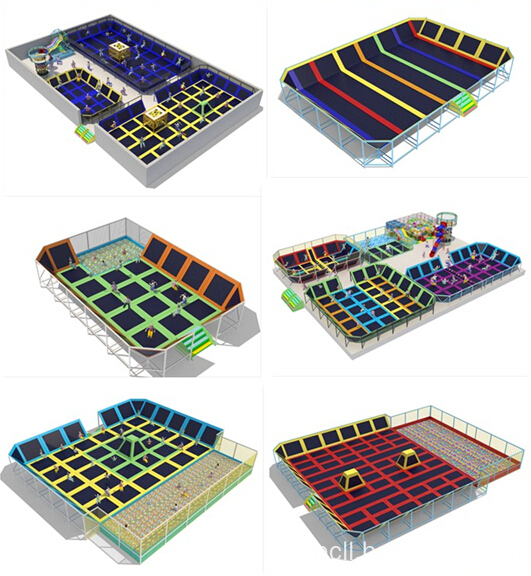
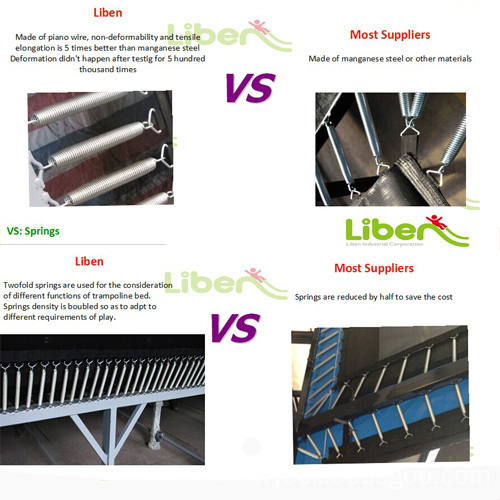
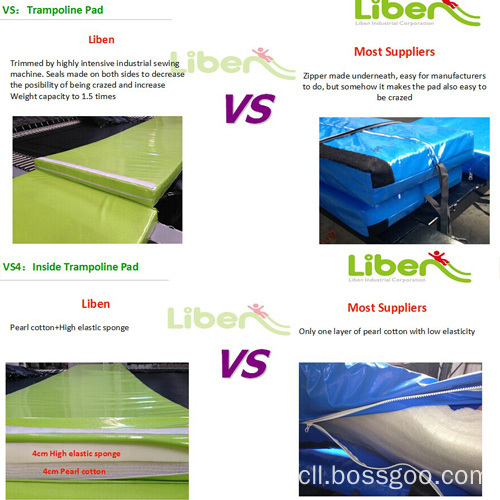

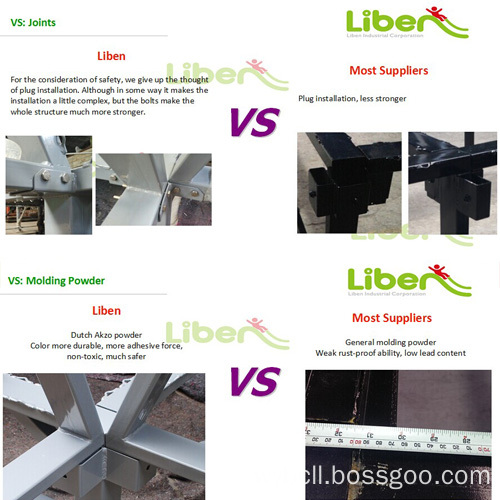

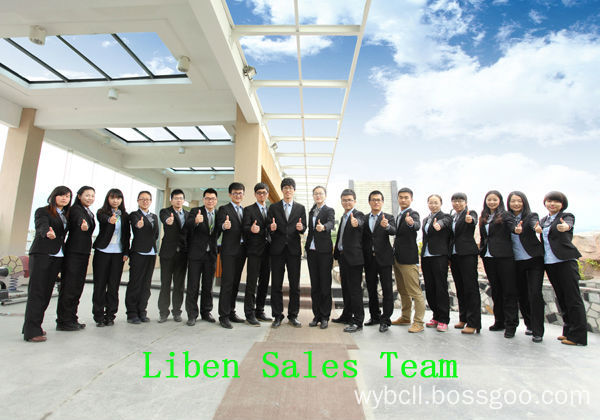
Olympic Professional Trampoline
Olympic Professional Trampoline, Professional Trampoline Park, Adult Trampoline Park,New Trampoline Park
Liben Group Corporation , http://www.trampolinearea.com